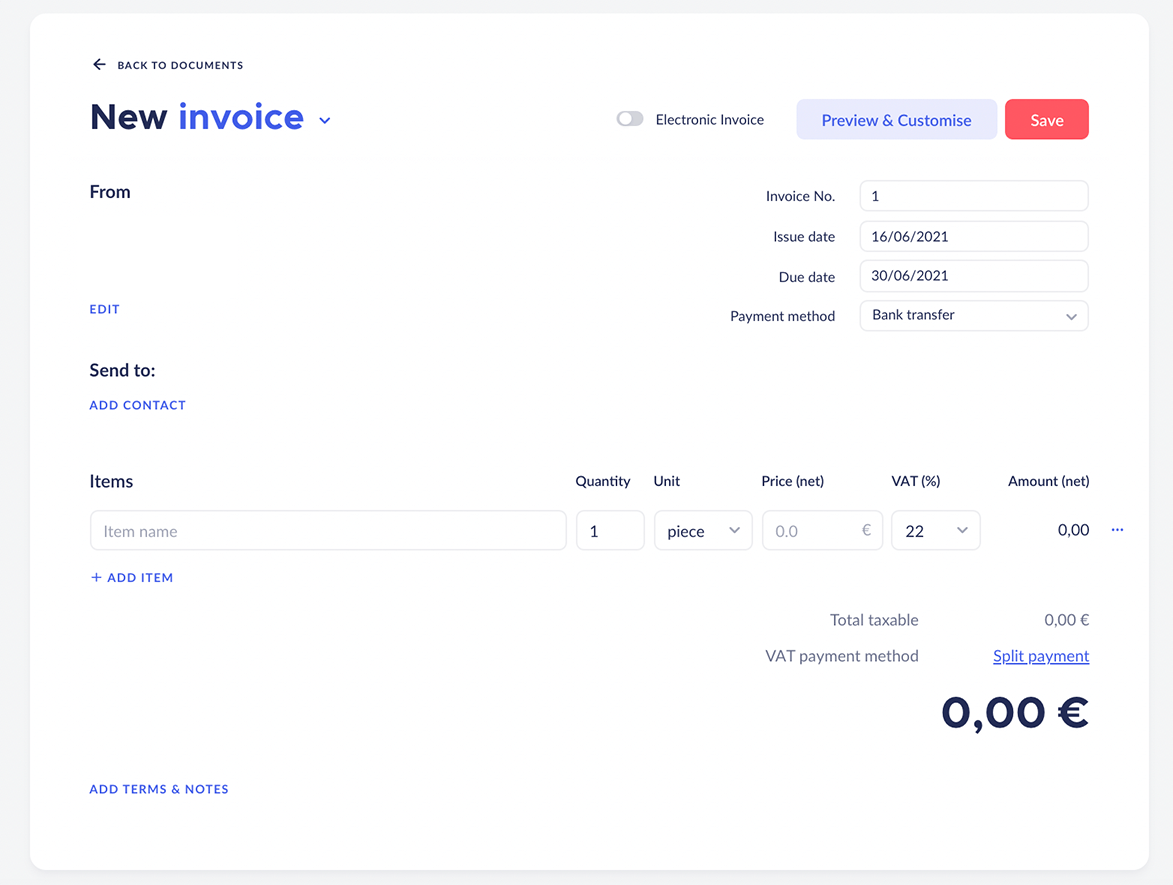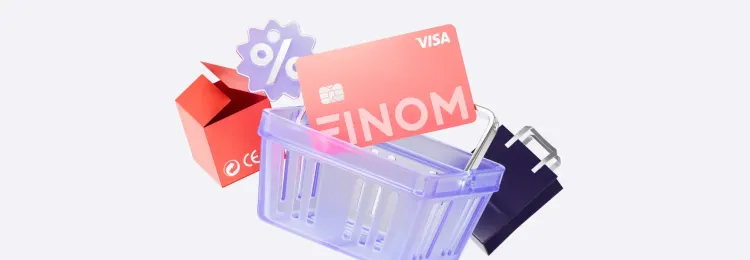Most people who use or give all sorts of business services come across paperwork. It is inevitable, even with the development of modern technologies. Invoices are among the most commonly met documents when it comes to business interactions. But what is an invoice? In plain words, an invoice is a document that regulates business relations between a buyer and a seller. It shows what services or goods a vendor is going to sell to a buyer and how much it will cost. The payment terms are also included, as well as other important information we will dwell upon later in this guide. While the concept of the document seems to be easy to understand, there might be some misleading aspects in terms of its structure and functionality. Let’s take a look at a historical reference, as well as the basic types and functions of invoices.
Finom tips: How to create an invoice with Finom?
Invoice Formation ー From the Past to the Present
Before paper currency was introduced, society started off with a bartering system. The first paper currency was invented in China at the beginning of the 10th century. Later on, the banking system evolved from individual lending. The age of credit loans and mortgages is still in full swing, alongside the growing interest in cryptocurrencies. However, it doesn’t matter which payment method you use. There should always be a document that lists all services and their prices to make things clear for both sides of business relations.
This simple fact was evident even for the ancient Sumerians. The merchants used clay or stone tablets with carvings on them as a form of early bookkeeping. But how could these primitive invoices confirm their authenticity? The first signatures and seals appeared on invoices made of animal skin, papyrus, and, finally, paper. All these features served as a means of protection and confirmed the genuineness of the document. The age of “paper supremacy” is still not over, yet the document flow is becoming more and more digitalized.
As soon as computers became an integral part of business activity, there came electronic invoices. This helped to reduce the time, effort, and cost of their creation. With the development of the Internet, it became possible to speed up the delivery of invoices to buyers and make all transactions online. Nowadays, technology is becoming even more compact and portable. This allows everyone to trade and offer any goods or services to customers right from a smartphone during their coffee break. There is even special software to make the whole process of invoicing almost fully automated.
Despite coming such a long way from clay to a digital environment, the content and functions of a typical invoice remain almost unaltered. Let’s take a closer look at these two issues.
Business account with online accountingInvoice Functions
Everything has its purpose and invoicing is not an exception. You will be surprised to learn how important that document is. Among the most significant functions of a typical invoice are:
- Keeping records of transactions. Being, probably, the most important function of all, an invoice leaves a distinctive paper trail of business activity. It shows who is responsible for providing services or delivering goods, payment details, and terms of contract performance.
- Accountants’ best helper. What is an invoice in accounting? Following the previous point, they are indispensable for bookkeeping. These documents are used to determine the total amount of accounts payable and receivable. Besides, invoices serve as records for taxable revenue, helping a company to report its income. Good invoicing can be an additional ace up your sleeve in case of an audit.
- Legal representation. Invoices can serve as reliable mediation of possible disputes between the buyer and seller. This way, the chances for fraudulent activity on both sides are considerably diminished.
- A powerful tool for analytics. Invoices assist in collecting information about customer buying habits, most commonly ordered types of goods or services, peak buying times, etc. This data will be quite valuable for planning further business development.
As you can see, invoicing can fulfill a wide range of business tasks. It provides clear information on the order for both parties and leaves practically no room for fraud.
Finom tips: Can I create documents in a currency other than the euro?
Types of Invoices
Different invoices serve different purposes. The type of invoicing depends on the area of business you operate in and whether the purchase has already been confirmed. The most common types of invoices are:
- Pro forma invoice. These documents are sent to a customer before the goods are delivered or services are executed. Such invoices generally provide an overview of the upcoming costs. The terms here might change during the course of the action. Still, the initial figures must be negotiated by the vendor and the customer to avoid misunderstandings in the future.
- Interim invoice. They are typical for large-scaled projects where payments are carried on across multiple bills. This way, each stage of the project is to be paid for. It is convenient for the seller, as there’s no need to wait till the end of the project to collect the revenue. Customers can monitor their budget and regulate the cash flow considering the invoice data.
- Recurring invoice. It is usually set for services that are executed within a set period of time. For instance, let’s say you represent a commercial agency and provide your customers with advertising services. If you require monthly payments, you’ll make up a recurring invoice for your clients.
- Sales invoice. This type of invoice is usually confused with a pro forma invoice. Though being similar in notion, there are some differences between these documents. A pro forma invoice reflects a certain amount of goods or services yet to be delivered. In other words, it is set before placing the order, so a buyer could learn the details of the bargain. A sales invoice guarantees the confirmation of a sale. It says something like: “Mr. Smith, you want us to deliver 20 computers for your office. You have to pay $16,000 for this purchase. The due date is November 30.”
The computers are already packed and ready to be delivered since Mr. Smith has given his confirmation. In other words, a sales invoice is usually made in the final stage of the bargain, while a pro forma invoice does not necessarily guarantee a successful deal. This is why sales invoices have entries in the accountant book, while pro forma invoices don’t.
- Commercial invoice. Such invoices are made for goods or services being exported. Since there are tariffs for export, commercial invoices are usually more detailed and contain additional information, such as the contacts of both parties, including contact information, a list of exported items (including their number and reasons for exportation), the place of origin and destination, and packaging details.
- Past due invoice. Perhaps, it is the saddest kind of all for the vendor. When a client isn’t willing or capable to pay for the services, he gets a past due invoice. Retrieving debts might become a nightmare for any entrepreneur. However, if your invoices are transparent and well-structured, the risk of dealing with past due deals is considerably reduced.
Such an abundance of documents should not be puzzling. The choice of an invoice depends primarily on the type of business you own. The most frequently met invoices are pro forma and sales invoices since they are often made up in the small business sector (though not limited to it). However, the definitions of an invoice, a bill, a purchase order, and a receipt might need a better explanation. Here we go, then!
Discover AI AccountingWhat Does An Invoice Mean in Relation to Similar Financial Documents?
Since we have already talked about the meaning of an invoice, let’s outline how an invoice differs from other business documentation.
Invoice vs. Receipt
Despite being much alike, these two documents are not the same. The receipt serves as legal proof of the purchase made by the customer. The goods can be returned or exchanged if a buyer owns the receipt. An invoice may serve as a preliminary estimation of services to be executed. Consider it as a draft of a future business deal.
Invoice vs. Bill
These two items are similar in two aspects: they both state the sum of money a client is obligated to pay to the seller and are released before the actual payment. So, what’s the difference? As usual, the devil is in the details. An invoice obligates the client to pay some time later and has a specified time limit. As for the bill, the payment is expected to carry out right away. Thus, a buyer does not have time to delay the payment.
Invoice vs. Purchase Order
In this case, everything is quite simple. An invoice is sent by the seller to the buyer. With a purchase order, it is vice-versa. The buyer makes up a purchase order to shape the terms of the deal and follow the purchasing process to its final stages. Thus, purchase orders prove the buyer’s intention to pay for the services, while invoices state a vendor’s desire to receive the funds for the services that have already been executed. You can find out more about invoices and purchase orders in our article “PO vs. Invoice: What Are the Differences Between These Financial Terms?”
Now that you have learned the notions of the described terms, it’s necessary to understand the importance of their practical implementation in business. If you are a company owner, make sure that your accounting works with all these types of financial documents. The more consistent bookkeeping is, the more legal protection you’ll receive if there is a dispute. Every document leaves its mark and may serve as evidence in court.
We have already discussed what an invoice is in business and accounting. It’s high time we paid attention to its actual appearance.
What Does An Invoice Look Like?
There are various invoice templates fitting each particular business case. Let’s have a look at one of the possible examples.

A typical invoice should include the following facets:
- Contact information. This concerns both sides of the agreement. The postal address is also advisable to mention - even in the case of an e-invoice. The client might want to receive a physical copy as well.
- The date of formation. The date of an invoice sets the countdown for the customer to fulfill his obligations.
- Terms. This is how a buyer should pay a seller. Usually, the column has the “Net” mark and a figure near it, like Net 15, Net 20, etc. It stands for the number of days given to a customer to commit the payment. However, there are other options as well, like “due upon receipt” in our case.
- Invoice number and customer ID. These figures are crucial for keeping things organized. Make sure that all invoices are assigned to a unique code. These numbers are not chosen accidentally. As a rule, they are placed in chronological order and can be accompanied by letters or other symbols. This makes it possible to trace back all the invoices sent to a particular client.
- The description of services. Each service should have its own line with all the adjacent information, including unit price and the total amount with taxes and discounts (if any).
The structure of that document hints at the possible standardization of invoicing. The automation of this process could surely benefit all types of businesses. This is where e-invoicing comes in handy.
Learn more about FinomFinom tips: How to personalize your invoice with Finom?
Benefits of E-Invoicing
To make invoicing less time-consuming and more efficient in terms of receiving payments, it would be wise to use a modern approach. Online invoicing is becoming nearly indispensable these days since it helps to make accounting easier and more economical. What are the methods of going online with this matter?
First of all, Microsoft offers a rich choice of invoice templates. They are free to download and are quite flexible in terms of necessary adjustments. You can use either Word or Excel templates as downloadable content or go fully online with Google Sheets templates. Besides, there are different online generators that perform the same function - making up the structure of the document. But what if you want to get more than that? Is it possible? With Finom - surely it is.
Finom takes invoicing to a brand new level, allowing all participants of a business relationship to feel comfortable in the financial documents flow. Here, you can make an invoice that will be automatically generated and filled in - all that on the screen of your phone. The whole matter won’t take longer than 60 seconds.
The client will get an invoice with a link to submit the payment in one click. Besides, the mobile app (Finom for Android, Finom for IOS) has a reminder function so that none of the invoices will be forgotten by your clients. And the cherry on top is banking integration. Finom checks the revenue from each invoice with their total amount to make sure that all payments are complete. This way, your accounting department has a reduced workload and saves time for other important matters to take care of.
An Invoice - What Is It?
Going full auto invoicing or not - that is the question each person must answer on their own. Naturally, it mostly depends on the scale of business. For small businesses, it might be worth saving funds for manual invoicing, while big players may prefer to speed the document flow up. Anyway, whether you stick to a traditional approach or take advantage of top-notch methods, make sure your invoicing remains clear and substantial for clients. This increases the chances of timely payments and smooth business activity.
Last articles

Finom plans are changing – what it means for you

The Best CRMs for Small Businesses: How to Find Your Perfect Software

Everything You Need to Know About a Bank Statement

How to Open a Company in Germany: Tips, Info, and More

Experience the future of business banking: FINOM Enhances German Financial Services with Advanced Banking Features

Finom Raises €50M in Series B Funding Led by General Catalyst and Northzone

Passkeys: Powering Finom’s Security Upgrade


